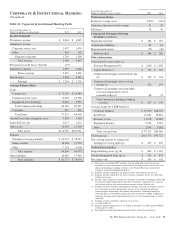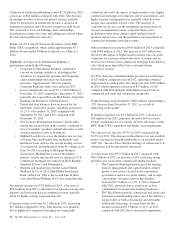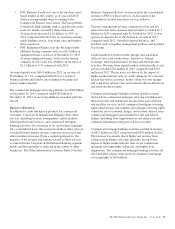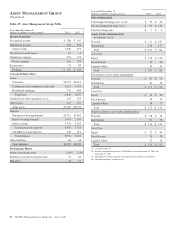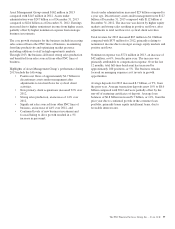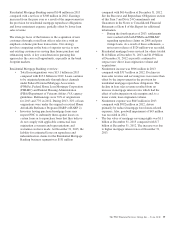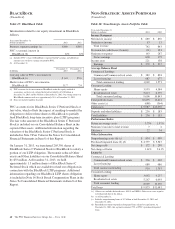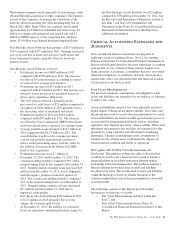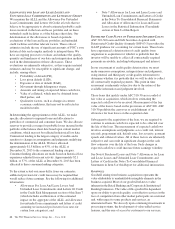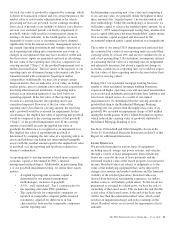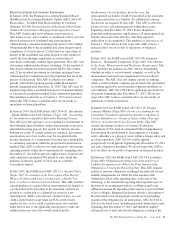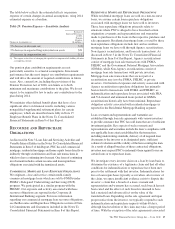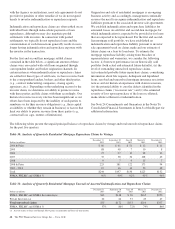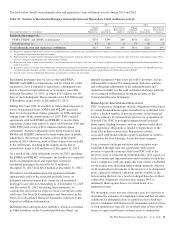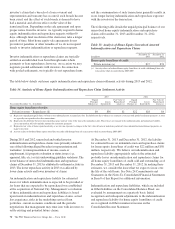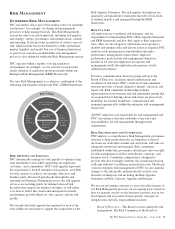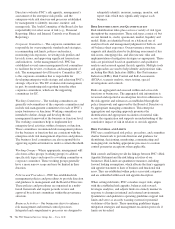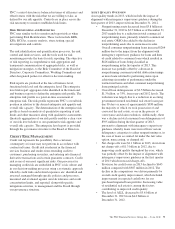PNC Bank 2013 Annual Report Download - page 81
Download and view the complete annual report
Please find page 81 of the 2013 PNC Bank annual report below. You can navigate through the pages in the report by either clicking on the pages listed below, or by using the keyword search tool below to find specific information within the annual report.As such, the value of goodwill is supported by earnings, which
is driven by transaction volume and, for certain businesses, the
market value of assets under administration or for which
processing services are provided. Lower earnings resulting
from a lack of growth or our inability to deliver cost-effective
services over sustained periods can lead to impairment of
goodwill, which could result in a current period charge to
earnings. At least annually, in the fourth quarter, or more
frequently if events occur or circumstances have changed
significantly from the annual test date, management reviews
the current operating environment and strategic direction of
each reporting unit taking into consideration any events or
changes in circumstances that may have an effect on the unit.
For this review, inputs are generated and used in calculating
the fair value of the reporting unit, which is compared to its
carrying amount (“Step 1” of the goodwill impairment test) as
further discussed below. The fair values of the majority of our
reporting units are determined using a discounted cash flow
valuation model with assumptions based upon market
comparables. Additionally, we may also evaluate certain
financial metrics that are indicative of fair value, including
market quotes, price to earnings ratios and recent acquisitions
involving other financial institutions. A reporting unit is
defined as an operating segment or one level below an
operating segment. If the fair value of the reporting unit
exceeds its carrying amount, the reporting unit is not
considered impaired. However, if the fair value of the
reporting unit is less than its carrying amount, the reporting
unit’s goodwill would be evaluated for impairment. In this
circumstance, the implied fair value of reporting unit goodwill
would be compared to the carrying amount of that goodwill
(“Step 2” of the goodwill impairment test). If the carrying
amount of goodwill exceeds the implied fair value of
goodwill, the difference is recognized as an impairment loss.
The implied fair value of reporting unit goodwill is
determined by assigning the fair value of a reporting unit to its
assets and liabilities (including any unrecognized intangible
assets) with the residual amount equal to the implied fair value
of goodwill as if the reporting unit had been acquired in a
business combination.
A reporting unit’s carrying amount is based upon assigned
economic capital as determined by PNC’s internal
management methodologies. Additionally, in performing Step
1 of our goodwill impairment testing, we utilize three equity
metrics:
• Assigned reporting unit economic capital as
determined by our internal management
methodologies, inclusive of goodwill.
• A 6%, “well capitalized”, Tier 1 common ratio for
the reporting unit under PNC guidelines.
• The capital levels for comparable companies (as
reported in comparable company public financial
statements), adjusted for differences in risk
characteristics between the comparable companies
and the reporting unit.
In determining a reporting unit’s fair value and comparing it
to its carrying value, we generally utilize the highest of these
three amounts (the “targeted equity”) in our discounted cash
flow methodology. Under this methodology, if necessary, we
will infuse capital to achieve the targeted equity amount. As of
October 1, 2013 (annual impairment testing date), unallocated
excess capital (difference between shareholders’ equity minus
total economic capital assigned and increased by the
incremental targeted equity capital infusion) was insignificant.
The results of our annual 2013 impairment test indicated that
the estimated fair values of our reporting units exceeded their
carrying values by at least 10% and are not considered to be at
risk of not passing Step 1. By definition, assumptions utilized
in estimating the fair value of a reporting unit are judgmental
and inherently uncertain, but absent a significant change in
economic conditions of a reporting unit, we would not expect
the fair values of these reporting units to decrease below their
respective carrying values.
During 2012, our residential mortgage banking business,
similar to other residential mortgage banking businesses,
experienced higher operating costs and increased uncertainties
such as elevated indemnification and repurchase liabilities and
foreclosure related issues. As a result of our annual
impairment test, we determined that the carrying amount of
goodwill relating to the Residential Mortgage Banking
reporting unit was greater than the implied fair value of its
goodwill. We recorded an impairment charge of $45 million
during the fourth quarter of 2012 within Noninterest expense
which reduced the carrying value of goodwill attributed to
Residential Mortgage Banking to zero.
See Note 10 Goodwill and Other Intangible Assets in the
Notes To Consolidated Financial Statements in Item 8 of this
Report for additional information.
L
EASE
R
ESIDUALS
We provide financing for various types of equipment,
including aircraft, energy and power systems, and vehicles
through a variety of lease arrangements. Direct financing
leases are carried at the sum of lease payments and the
estimated residual value of the leased property, less unearned
income. Residual values are subject to judgments as to the
value of the underlying equipment that can be affected by
changes in economic and market conditions and the financial
viability of the residual guarantors. Residual values are
derived from historical remarketing experience, secondary
market contacts, and industry publications. To the extent not
guaranteed or assumed by a third-party, we bear the risk of
ownership of the leased assets. This includes the risk that the
actual value of the leased assets at the end of the lease term
will be less than the estimated residual value, which could
result in an impairment charge and reduce earnings in the
future. Residual values are reviewed for impairment at least
annually.
The PNC Financial Services Group, Inc. – Form 10-K 63


